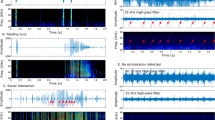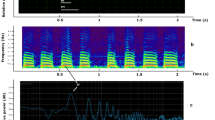Abstract
THE lepidopteran family Arctiidae contains a number of species that emit high frequency sounds when tactually stimulated or exposed to the intense hunting cries of insectivorous bats1–3. The sounds are produced as rapidly repeated clicks generated by the buckling action of the row of striae4 or microtymbals5 on the surface of the modified metepisternum (tymbal)6. The sounds seem to act as aposematic cues to discourage nocturnal, ultrasonically sensitive predators such as bats3. Flying bats will avoid otherwise palatable prey (mealworms) when accompanied by the recorded sounds of arctiid moths2. If bats play an important role in the evolution of sound production in arctiids then bat activity levels in an area should influence the phenology of acoustically active arctiids there. By examining the incidence of some silent and sound-producing Nearctic arctiids and its relationship to ambient levels of bat activity, some of those influences can be demonstrated.
This is a preview of subscription content, access via your institution
Access options
Subscribe to this journal
Receive 51 print issues and online access
$199.00 per year
only $3.90 per issue
Buy this article
- Purchase on Springer Link
- Instant access to full article PDF
Prices may be subject to local taxes which are calculated during checkout
Similar content being viewed by others
References
Blest, A. D. Zoologica 49, 161–181 (1964).
Dunning, D. C. & Roeder, K. D. Science 147, 173–174 (1965).
Dunning, D. C. Z. Tierpsychol. 25, 129–138 (1968).
Forbes, W. T. M. & Franclemont, J. C. Lep. News 11, 147–150 (1957).
Fenton, M. B. & Roeder, K. D. J. Lep. Soc. 28, 205–211 (1974).
Blest, A. D., Collett, T. S. & Pye, J. D. Proc. R. Soc. Lond. B, 196–207 (1963).
Fullard, J. H., thesis, Carleton Univ. (1976).
Fenton, M. B., Jacobson, S. L. & Stone, R. N. Can. J. Zool. 51, 291–299 (1973).
Fullard, J. H. J. N. Y. Ent. Soc. (in the press).
Holland, W. J. The Moth Book, plate XIII: 41, 42 (Dover, New York, 1968).
Edmunds, M. Defence in Aminals, A Survey of Anti-Predator Defence, 232–243 (Longmans, New York, 1974).
Roeder, K. D. Can. Soc. Zool. Ann. Meet. Proc. 71–78 (University of New Brunswick, Fredricton, 1974).
Author information
Authors and Affiliations
Rights and permissions
About this article
Cite this article
FULLARD, J. Phenology of sound-producing arctiid moths and the activity of insectivorous bats. Nature 267, 42–43 (1977). https://doi.org/10.1038/267042a0
Received:
Accepted:
Issue Date:
DOI: https://doi.org/10.1038/267042a0
This article is cited by
-
Multimodal warning signals for a multiple predator world
Nature (2008)
-
Acoustic courtship communication inSyntomeida epilais Wlk. (Lepidoptera: Arctiidae, Ctenuchinae)
Journal of Insect Behavior (1995)
-
Passive sound localization of prey by the pallid bat (Antrozous p. pallidus)
Journal of Comparative Physiology A (1993)
-
Acoustic signaling, territoriality, and mating in whistling moths,Hecatesia thyridion (Agaristidae)
Journal of Insect Behavior (1989)
-
Olfactory aposematism
Journal of Chemical Ecology (1985)
Comments
By submitting a comment you agree to abide by our Terms and Community Guidelines. If you find something abusive or that does not comply with our terms or guidelines please flag it as inappropriate.



